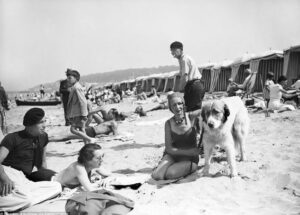
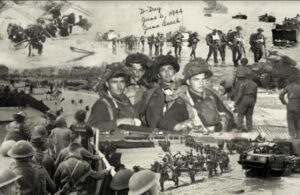 Over the years, many people have collected postcards. Some like them for the scenic views, and some collect postcards that have been sent to them, saving them as mementos of family members who won’t always be with us. I have picked up lots of postcards for my sister, Cheryl Masterson, who has a collection. While this is a cool way to get great pictures of amazing places, postcards were once used as…intel.
Over the years, many people have collected postcards. Some like them for the scenic views, and some collect postcards that have been sent to them, saving them as mementos of family members who won’t always be with us. I have picked up lots of postcards for my sister, Cheryl Masterson, who has a collection. While this is a cool way to get great pictures of amazing places, postcards were once used as…intel.
Starting in 1942, as the BBC, as part of their planning of the D-Day attack, issued a public appeal for postcards and photographs of mainland Europe’s coast, from Norway to the Pyrenees. The British people were eager to help and began sending in postcards and pictures from their trips to France. Other families began searching through boxes of family photos, searching for anything that might show the beaches. Photos of kids building 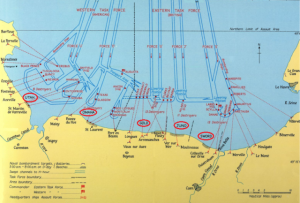 sandcastles, and people lounging on the beach flooded the BBC offices. While it all seemed like a fun project, the people had no idea that their family photographs would prove very instrumental in the D-Day landings. Within 36 hours, over 30,000 packs of pictures of the French coast arrived at the BBC offices. Even more incredible was the fact that by 1944, 10 million holiday snaps and postcards, hotel brochures, letters and guidebooks had arrived by post. Once there, the postcards and photographs were sorted, and the best ones were pinned to a board in a top-secret planning room. Then the army bosses began to study every inch of the beaches and landing areas where the Normandy invasion would go on to take on June 6, 1944.
sandcastles, and people lounging on the beach flooded the BBC offices. While it all seemed like a fun project, the people had no idea that their family photographs would prove very instrumental in the D-Day landings. Within 36 hours, over 30,000 packs of pictures of the French coast arrived at the BBC offices. Even more incredible was the fact that by 1944, 10 million holiday snaps and postcards, hotel brochures, letters and guidebooks had arrived by post. Once there, the postcards and photographs were sorted, and the best ones were pinned to a board in a top-secret planning room. Then the army bosses began to study every inch of the beaches and landing areas where the Normandy invasion would go on to take on June 6, 1944.
The families who sent in their family photographs and postcards, had no idea what would come of their contribution. They weren’t told why their pictures were needed, just that it was an important project. Looking at the photographs now, the innocent snaps almost bring a feeling of deep sadness. Nevertheless, the photographs and postcards were instrumental and extremely important to the war effort. After looking at all the 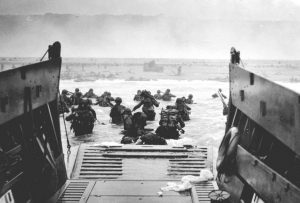
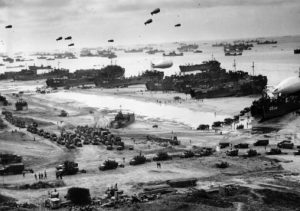 pictures, it was decided that the best place to carry out their plan was on the beaches at Normandy, France. Many of these postcards were used in briefings with officers, land craft operators and other infantry soldier to study and orient themselves based on their drop locations of the building and landmarks in these photos. Of course, the rest is history, and the operation to storm the beaches at Normandy was a great success.
pictures, it was decided that the best place to carry out their plan was on the beaches at Normandy, France. Many of these postcards were used in briefings with officers, land craft operators and other infantry soldier to study and orient themselves based on their drop locations of the building and landmarks in these photos. Of course, the rest is history, and the operation to storm the beaches at Normandy was a great success.
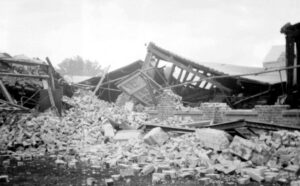
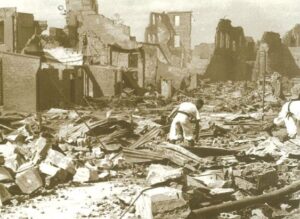 February 3, 1931, dawned beautiful and calm in Hawke’s Bay, New Zealand, but by the end of the day, few people would be thinking of how the day had started out. At exactly 10:47am the hands of the clock on the band rotunda in Napier stopped turning. That was the moment when the area was hit by a massive 7.8 magnitude earthquake. The quake shook the area for a full three minutes, causing such destruction that it actually changed the topography of the area forever. Buildings were leveled, streets were destroyed, fires broke out, power and phone lines were knocked out, and 256 people lost their lives…161 in Napier, 93 in Hastings, and two in Wairoa. Many thousands more were injured. The 1931 Hawke’s Bay earthquake the deadliest natural disaster in New Zealand’s history.
February 3, 1931, dawned beautiful and calm in Hawke’s Bay, New Zealand, but by the end of the day, few people would be thinking of how the day had started out. At exactly 10:47am the hands of the clock on the band rotunda in Napier stopped turning. That was the moment when the area was hit by a massive 7.8 magnitude earthquake. The quake shook the area for a full three minutes, causing such destruction that it actually changed the topography of the area forever. Buildings were leveled, streets were destroyed, fires broke out, power and phone lines were knocked out, and 256 people lost their lives…161 in Napier, 93 in Hastings, and two in Wairoa. Many thousands more were injured. The 1931 Hawke’s Bay earthquake the deadliest natural disaster in New Zealand’s history.
The earthquake left the people in shock, as they surveyed the damage to their beautiful seaside city. People had trouble breathing, due to dust clouds from shattered buildings, and the roads were filled with huge splits making it impossible to get emergency equipment into the area. When the initial shaking began, people ran panic-stricken out of the buildings and into the street. Many of them were killed instantly when they were struck by falling masonry, as stone decorations on many buildings crashed to the ground. Still others were buried alive in the rubble as the buildings collapsed. To make matters worse, fires were burning throughout the city of Napier for a full 36 hours before they could be contained. Most of the surviving buildings from the initial impact of the quake, were leveled by the fires. Nearby Hastings lost approximately 200 buildings and most of the deaths there were in a single department store, although many died in the public library too. Hastings also suffered from out-of-control fires due to problems with their water supply, but fires weren’t as bad as in Napier.
While the earthquake was a major tragedy, there were numerous acts of heroism that will never be forgotten. 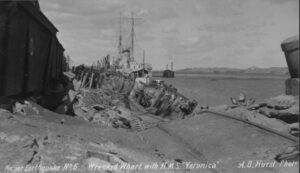 Water for fighting the fires ran out because underground pipes had cracked and broken. Fire engines at Napier’s central fire station were covered in debris from the destroyed brigade building, and they couldn’t be used when fires broke out in the town anyway. Napier Hospital, built only a year earlier, collapsed, claiming the lives of 12 nurses. Rescuers fought to bring out trapped and injured victims from the rubble before the fires reached them. Still, many died in the terrible inferno. With the loss of the Napier Hospital, first responders quickly set up emergency hospitals. Unfortunately, the hospitals lacked the necessary medical supplies, and so the doctors and nurses were limited in what they could do to help the injured. Back-up medical teams were sent from Auckland on board Navy ships and from Wellington by train, but this took time to arrange, and with communication largely out, the communications had to be routed through ships in the harbor, like the HMS Veronica, which had just tied up in the harbor when the quake hit. At first her captain thought there had been an explosion on board…until he saw the wharf twisting and beyond it houses and other buildings crumpling to the ground. It was then that the sickening reality hit him. He quickly sent his sailors ashore to assist with the rescue effort. By the morning of February 4, 1931, the area was filled with rescue workers trying to save anyone they could. Unfortunately, for many, help came too late. Still, a full three days after the quake a 90-year-old man who was buried in the earthquake rubble was finally dug out alive. Miracles do happen.
Water for fighting the fires ran out because underground pipes had cracked and broken. Fire engines at Napier’s central fire station were covered in debris from the destroyed brigade building, and they couldn’t be used when fires broke out in the town anyway. Napier Hospital, built only a year earlier, collapsed, claiming the lives of 12 nurses. Rescuers fought to bring out trapped and injured victims from the rubble before the fires reached them. Still, many died in the terrible inferno. With the loss of the Napier Hospital, first responders quickly set up emergency hospitals. Unfortunately, the hospitals lacked the necessary medical supplies, and so the doctors and nurses were limited in what they could do to help the injured. Back-up medical teams were sent from Auckland on board Navy ships and from Wellington by train, but this took time to arrange, and with communication largely out, the communications had to be routed through ships in the harbor, like the HMS Veronica, which had just tied up in the harbor when the quake hit. At first her captain thought there had been an explosion on board…until he saw the wharf twisting and beyond it houses and other buildings crumpling to the ground. It was then that the sickening reality hit him. He quickly sent his sailors ashore to assist with the rescue effort. By the morning of February 4, 1931, the area was filled with rescue workers trying to save anyone they could. Unfortunately, for many, help came too late. Still, a full three days after the quake a 90-year-old man who was buried in the earthquake rubble was finally dug out alive. Miracles do happen.
Napier was forever changed from this devastating tragedy. The Ahuriri Lagoon and tidal flats that was once a large body of water was completely emptied, and today the area is the site of the Hawke’s Bay Airport. The sea floor just off Hawke’s Bay was lifted approximately 8 feet 10 inches. The main fault, which was buried under the earth’s surface heaved up the land, setting off two smaller faults which broke on the surface. Following the terrible devastation, came resilience and determination in the people, and the area would be rebuilt and 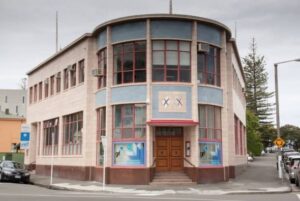
 improved. The streets were widened when they rebuilt, and services were improved, including New Zealand’s first underground power system. The architectural fashion of the time was known as Art Deco, and central Napier is almost entirely built in variations of this style. One beautiful legacy from an otherwise tragic chapter of Napier’s history.
improved. The streets were widened when they rebuilt, and services were improved, including New Zealand’s first underground power system. The architectural fashion of the time was known as Art Deco, and central Napier is almost entirely built in variations of this style. One beautiful legacy from an otherwise tragic chapter of Napier’s history.

 While my nephew, Dave Chase is a fun-loving, always active in every sport there’s a team for and the most sociable guy, his wife (my niece Toni) has ever met, what stands out above all, is his participation in family activities and his devotion to ALL of his family!! Dave took a number of trips this year, including a trip to San Diego, California for the NCAA Championship, a skiing trip to Winter Park in Utah, a fishing trip in Canada, a trip to Sturgis, South Dakota, several trips to Colorado for concerts and baseball, several trips to Centennial and Laramie, Wyoming for football games, basketball games, hiking and spending time with family, and a trip to Jackson Wyoming for hiking and sightseeing. Dave and Toni love to travel, and that has been a good thing for his whole family. Toni tells me, “Of course, I’ve always felt his love and kindness toward me and James and now Manuela and have always recognized him as the most unimaginably loyal and dependable patriarch of my little family that he is. BUT this goes way deeper, and I didn’t see it until I started thinking about what Dave has been up to in the last year. Dave’s devotion extends to his whole family circle. I could fill up the next 300 pages if I tried to cover all the examples that come to mind, but in an attempt to keep it short, I will just throw out a few.”
While my nephew, Dave Chase is a fun-loving, always active in every sport there’s a team for and the most sociable guy, his wife (my niece Toni) has ever met, what stands out above all, is his participation in family activities and his devotion to ALL of his family!! Dave took a number of trips this year, including a trip to San Diego, California for the NCAA Championship, a skiing trip to Winter Park in Utah, a fishing trip in Canada, a trip to Sturgis, South Dakota, several trips to Colorado for concerts and baseball, several trips to Centennial and Laramie, Wyoming for football games, basketball games, hiking and spending time with family, and a trip to Jackson Wyoming for hiking and sightseeing. Dave and Toni love to travel, and that has been a good thing for his whole family. Toni tells me, “Of course, I’ve always felt his love and kindness toward me and James and now Manuela and have always recognized him as the most unimaginably loyal and dependable patriarch of my little family that he is. BUT this goes way deeper, and I didn’t see it until I started thinking about what Dave has been up to in the last year. Dave’s devotion extends to his whole family circle. I could fill up the next 300 pages if I tried to cover all the examples that come to mind, but in an attempt to keep it short, I will just throw out a few.”
Dave has traveled to Laramie (sometimes on his own) just to accompany his mom to basketball games so that she doesn’t have to go alone. Dave is very loving and loyal to his mom, and since his dad passed away, he has made sure that she can still do the things she likes to do. He took his mom, sister, and Toni to Sturgis, South Dakota, so that they could all see their dad and sister’s new headstone together. Then, when Jane (his sister) and Nancy (their mother) were preparing to leave the following morning, it was discovered that his sister’s tire had a slow leak. Dave insisted that she take his car back to Laramie and on to Colorado where Jane lives to ensure their safe travel. Dave and Toni took Janes car back to her the following week, complete with a new tire. Dave and his brother both enjoy hiking, so Dave went to Centennial days in advance to hike with his brother, Dan before everybody else got there…just to have time with his brother.
Dave has been a great blessing to his mother-in-law (my sister, Cheryl Masterson), treating her just like he does his mom. Taking care of her lawn is difficult for Cheryl, and Dave just took it upon himself to take on that job. Cheryl tells me, “Dave has been such a blessing to me, and our family, ever since he and Toni began dating. He honestly took our family to heart from the very beginning!! He just accepted us all as his own and made each one of us his friend with his hilarious sense of humor, and his kindness!! He brings those traits with him to  every family event, and to church on Sunday!! He continually looks for ways to be a blessing. He’s a man who always likes to be busy. He sees a need, and he finds a way to fill that need. I can’t tell you the countless times he has come by my house on a Saturday just to rake up the leaves in my yard! Or how he’s made space in his garage to store some of the guys in our family’s motorcycles in the winter, or the times he and Toni have taken some of my grandchildren to their home just because they were bored, and fed them, entertained them, got them out of their parent’s hair, and made them happy for a while. Or the times he has gone far beyond what could ever be expected to meet a need greater than I could ever afford!! And above all else, he is a wonderful husband to my daughter, Toni, and a wonderful stepdad to my grandson, James and to James’ wife, Manuela.” Dave is so thoughtful, and everyone around him becomes the beneficiary of his kindness. He gave up his second-row seat to “Hamilton” to Toni’s sister, Elizabeth Masterson, because he knew how badly she wanted to go. Tonie told me that “just in the last 5 days he went out of his way (at 6:30 am) to WalMart for the sole purpose of buying me a space heater because my feet were cold. And he made a deal with James and Manuela to get me James’s Mustang knowing that I couldn’t stand to see it sold to anybody else.”
every family event, and to church on Sunday!! He continually looks for ways to be a blessing. He’s a man who always likes to be busy. He sees a need, and he finds a way to fill that need. I can’t tell you the countless times he has come by my house on a Saturday just to rake up the leaves in my yard! Or how he’s made space in his garage to store some of the guys in our family’s motorcycles in the winter, or the times he and Toni have taken some of my grandchildren to their home just because they were bored, and fed them, entertained them, got them out of their parent’s hair, and made them happy for a while. Or the times he has gone far beyond what could ever be expected to meet a need greater than I could ever afford!! And above all else, he is a wonderful husband to my daughter, Toni, and a wonderful stepdad to my grandson, James and to James’ wife, Manuela.” Dave is so thoughtful, and everyone around him becomes the beneficiary of his kindness. He gave up his second-row seat to “Hamilton” to Toni’s sister, Elizabeth Masterson, because he knew how badly she wanted to go. Tonie told me that “just in the last 5 days he went out of his way (at 6:30 am) to WalMart for the sole purpose of buying me a space heater because my feet were cold. And he made a deal with James and Manuela to get me James’s Mustang knowing that I couldn’t stand to see it sold to anybody else.”
Nancy Chase, Dave’s mom says, “Dave is always eager to help me with anything. – Changing light bulbs, moving deck furniture to and from the garage, replacing bad 2x4s on the deck. And he gives me hugs and put his arm around me when we visited Jim’s (Dave’s dad) grave in SD…” Of her brother, Jane says, “My brother Dave has always been a natural leader. He is intelligent, funny, athletic, stays active with numerous interests and makes friends wherever he goes. It’s easy to think of funny stories regarding Dave. This year, instead of sharing some of Dave’s funny antics, I’d like to share something more meaningful. As you may know, we lost our dad just over a year ago. Throughout all the sadness and aftermath, Dave showed his true strength, gentle kindness, and love of family. Quietly and without fanfare, he has become our Chase family patriarch. I am grateful and he is perfect!” Bother, Dan says, “Some things that stand out for me about Dave over this last summer are he and I working on mom’s deck replacing deck slats, hiking in the Snowy Range and Dave always having to prove his strength by pushing dead Aspen trees down at the cabin.”
Manuela, Dave’s daughter-in-law, says, “We’re so happy for Dave’s life, he didn’t have children of his own, but life still gave him two. One is always teasing and making fun of him (James), and the other, “a little chocolate boss” who is just like him. (Manuela). Before James and I make any big decisions, we always ask Dave for his opinion or advice, because we know how much he knows. And even though Dave always says that he is the boss, the truth is that Toni and Manuela are really Dave’s boss?” As you can see, Dave and Manuela really do share the same sense of humor!!
Some stories that I write are the kind that I have to think long and hard about, but some…like this one, are so 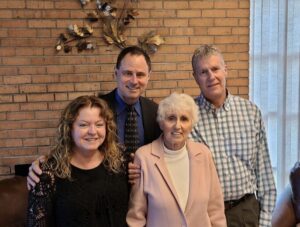
 easy, because the people who love and care for my subject (in this case, Dave Chase) have such deep feelings of love and respect for him that my words would pale by comparison. Dave is one of those people who makes life better for everyone he meets, and there truly is no better tribute than the honor and deep gratitude of those whose lives he has touched. Today is Dave’s birthday. Happy birthday Dave!! Have a great day!! We all love you!!
easy, because the people who love and care for my subject (in this case, Dave Chase) have such deep feelings of love and respect for him that my words would pale by comparison. Dave is one of those people who makes life better for everyone he meets, and there truly is no better tribute than the honor and deep gratitude of those whose lives he has touched. Today is Dave’s birthday. Happy birthday Dave!! Have a great day!! We all love you!!
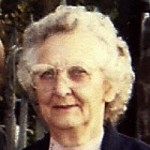
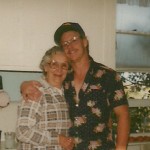 The first official Groundhog Day celebration in the United States took place on February 2, 1887, in Punxsutawney, Pennsylvania, but it had its roots in Germany and was brought to the United States as a German tradition. It may have had other connotations to some people, but for most of us, it’s just a fun way to break the monotony of Winter, by guessing how much longer it will last. It is my guess that old Punxsutawney Phil is wrong about the prediction as often as he is right about it.
The first official Groundhog Day celebration in the United States took place on February 2, 1887, in Punxsutawney, Pennsylvania, but it had its roots in Germany and was brought to the United States as a German tradition. It may have had other connotations to some people, but for most of us, it’s just a fun way to break the monotony of Winter, by guessing how much longer it will last. It is my guess that old Punxsutawney Phil is wrong about the prediction as often as he is right about it.
Since, my husband, Bob Schulenberg’s grandma, Vina Hein was born of Groundhog’s Day, the day has always been a little bit of a fun day for her. Of course, I suppose the level of “fun” would depend on the prediction for that year, and whether or not she liked Winter, which I don’t believe she did…as an adult anyway. Montana winters can be 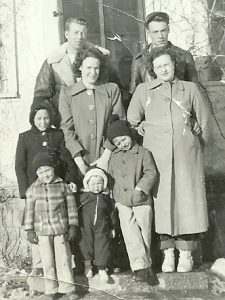 harsh, and Grandma even had to have her daughter Esther Hein live with her son, Walt Schulenberg, and his wife Joann during the winter, so she could be able to get to school more regularly. So, I’m sure she…like most of us, preferred an early Spring prediction, not that the prediction mattered much anyway. After all, what could she do if old Punxsutawney Phil guessed wrong? The same thing we can do today…nothing.
harsh, and Grandma even had to have her daughter Esther Hein live with her son, Walt Schulenberg, and his wife Joann during the winter, so she could be able to get to school more regularly. So, I’m sure she…like most of us, preferred an early Spring prediction, not that the prediction mattered much anyway. After all, what could she do if old Punxsutawney Phil guessed wrong? The same thing we can do today…nothing.
Grandma Hein stayed busy all year long. Between canning in the summer, cleaning, cooking and baking, as well as helping out with the garden and the animals on the ranch, life could sometimes be pretty fast paced. She also raised five children, two from her first marriage, Marion and Walt Schulenberg, and three from her second marriage, Esther, Eddie, and Butch Hein. A ranch, a husband, and five kids can keep a person very busy. Nevertheless, even with the hard work and distance from town, Grandma was happy in her life…most of the time. Having an outhouse wasn’t the easiest thing, but they had one the whole time they lived on the ranch. Grandpa did put one in the house later on, but they only used it in the winter. I’ll never forget using that outhouse. It was like living in a backwoods campground. Still, I loved going to visit Grandma and Grandpa Hein.
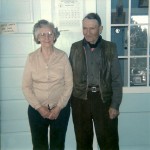

Today marks the 114th anniversary of Grandma Hein’s birth. She has been in Heaven a long time now of course, and I’m sure that the Winter on Earth makes no difference to her. Nevertheless, for any of you that do care, old Punxsutawney Phil saw his shadow today, so there will supposedly be six more weeks of Winter. My guess is that old Phil does better with his predicting when he sees his shadow than when he doesn’t. Happy birthday in Heaven, Grandma Hein. We love and miss you very much.
 Thankfully, the NASA space program hasn’t had a great number of losses, but that doesn’t make any loss less devastating that any of the others. On February 1, 2003, just a little over 17 years after the Challenger disaster, the country was once again feeling like the Space Shuttle program was so safe that it was even mundane. Many people had no idea when the shuttle flights went up or came down. It wasn’t the nation’s fault, it’s just that like air travel, the Shuttle program was relatively save, but when disaster strikes, we are once again reminded…horrifically, that relatively save does not mean completely safe from an accident. People are prone to get comfortable when things are going well. We forget the bad times. Nevertheless, space travel is not accident proof, even if it has become relatively safe.
Thankfully, the NASA space program hasn’t had a great number of losses, but that doesn’t make any loss less devastating that any of the others. On February 1, 2003, just a little over 17 years after the Challenger disaster, the country was once again feeling like the Space Shuttle program was so safe that it was even mundane. Many people had no idea when the shuttle flights went up or came down. It wasn’t the nation’s fault, it’s just that like air travel, the Shuttle program was relatively save, but when disaster strikes, we are once again reminded…horrifically, that relatively save does not mean completely safe from an accident. People are prone to get comfortable when things are going well. We forget the bad times. Nevertheless, space travel is not accident proof, even if it has become relatively safe.
On that awful February 1st morning in 2003, we were once again jolted out of our comfort zones and thrust  back into the reality that the Shuttle program might have some serious flaws. Still, the Space Shuttle program was a long running and highly successful program, running from 1981 to 2011. During the course of the program, a total of 135 missions were flown, all launched from Kennedy Space Center (KSC) in Florida. During that period of time, the fleet logged 1,322 days, 19 hours, 21 minutes and 23 seconds of flight time. The first orbiter built, Enterprise, was used for atmospheric flight tests (ALT) but future plans to upgrade it to orbital capability were ultimately canceled. Originally, NASA built four fully operational orbiters…Columbia, Challenger, Discovery, and Atlantis. Of course, we know that Challenger and Columbia were destroyed in mission accidents in 1986 and 2003 respectively, killing a total of fourteen astronauts. A fifth operational orbiter, Endeavour, was built in 1991 to replace Challenger. In the end, it was decided that the shuttles were getting old and had too many flaws, so the Space Shuttle was retired from service upon the conclusion of STS-135 by Atlantis on July 21, 2011.
back into the reality that the Shuttle program might have some serious flaws. Still, the Space Shuttle program was a long running and highly successful program, running from 1981 to 2011. During the course of the program, a total of 135 missions were flown, all launched from Kennedy Space Center (KSC) in Florida. During that period of time, the fleet logged 1,322 days, 19 hours, 21 minutes and 23 seconds of flight time. The first orbiter built, Enterprise, was used for atmospheric flight tests (ALT) but future plans to upgrade it to orbital capability were ultimately canceled. Originally, NASA built four fully operational orbiters…Columbia, Challenger, Discovery, and Atlantis. Of course, we know that Challenger and Columbia were destroyed in mission accidents in 1986 and 2003 respectively, killing a total of fourteen astronauts. A fifth operational orbiter, Endeavour, was built in 1991 to replace Challenger. In the end, it was decided that the shuttles were getting old and had too many flaws, so the Space Shuttle was retired from service upon the conclusion of STS-135 by Atlantis on July 21, 2011.
It was a piece of foam insulation that would bring down the Columbia shuttle. It broke off and hit the leading edge of the wing. That small little bit of damage to the wing allowed hot gases to enter the wing causing it to 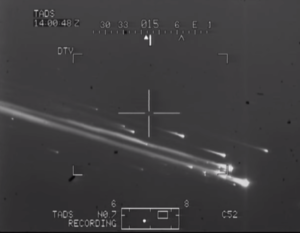 break up as the craft entered Earth’s atmosphere. During the breakup, debris and the bodies of the astronauts were strewn across the state of Texas. The breakup began over California at 8:53am, and by 8:59am, communication was lost. Mission Control began its disaster procedures at 9:12am. Lost in the disaster were Rick D Husband (Commander), William C McCool (Pilot), Michael P Anderson (Payload Commander), Ilan Ramon (Payload Specialist), Kalpana Chawla (an Indian-born aerospace engineer and a Mission Specialist), David M Brown (Mission Specialist), and Laurel Blair Salton Clark (Mission Specialist). Today, marks the 20th anniversary of that fateful day. Today, we honor those we lost.
break up as the craft entered Earth’s atmosphere. During the breakup, debris and the bodies of the astronauts were strewn across the state of Texas. The breakup began over California at 8:53am, and by 8:59am, communication was lost. Mission Control began its disaster procedures at 9:12am. Lost in the disaster were Rick D Husband (Commander), William C McCool (Pilot), Michael P Anderson (Payload Commander), Ilan Ramon (Payload Specialist), Kalpana Chawla (an Indian-born aerospace engineer and a Mission Specialist), David M Brown (Mission Specialist), and Laurel Blair Salton Clark (Mission Specialist). Today, marks the 20th anniversary of that fateful day. Today, we honor those we lost.
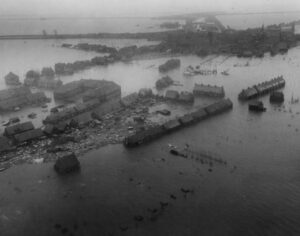
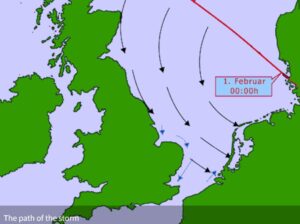 The early warning systems we have in place these days could have easily saved many of the lives of the 2551 people who lost their lives on January 31, 1953, during the North Sea Flood. The flood caused catastrophic damage and loss of life in Scotland, England, Belgium and The Netherlands. It became one of the worst peacetime disasters of the 20th century. In the course of the flood, 307 people died in England, 19 died in Scotland, 28 died in Belgium, 1,836 died in the Netherlands, and an additional 361 people died at sea.
The early warning systems we have in place these days could have easily saved many of the lives of the 2551 people who lost their lives on January 31, 1953, during the North Sea Flood. The flood caused catastrophic damage and loss of life in Scotland, England, Belgium and The Netherlands. It became one of the worst peacetime disasters of the 20th century. In the course of the flood, 307 people died in England, 19 died in Scotland, 28 died in Belgium, 1,836 died in the Netherlands, and an additional 361 people died at sea.
The North Sea Flood of 1953 was an unusual storm, that was caused by a number of contributing elements, that combined together to make it more deadly and devastating than the average storm or even the average flood. The annual spring tides, a deep pressure system…something that in itself can cause the sea to rise, combined with severe gale force winds…recorded at 126 miles per hour at Costa Hill in Scotland and the result was the North Sea Flood of 1953. All of these elements funneled those high tides southward toward the narrow, and shallow…just 571 feet deep, English Channel, causing the swell to rise even further. The storm surge was recorded at 18.4 feet at its peak.
The tide came in slowly at first, and nobody was alarmed. The official weather forecast was a slight drizzle and strong winds but nothing regarding waves and tidal flow. Life went on as usual, the ships set sail and people went to work or to play. Yes, life went on as usual…until it didn’t. What began as a calm evening was quickly changed into a nightmare. The tide became unpredictable and surged over the sea walls at different points during the evening, taking many by surprise and leaving no time to warn others. One survivor in Norfolk said, that it took less than 15 minutes from the water first tricking into his home, to reaching almost 5 feet. Those living closest to the sea reported that a wall of water came over almost immediately with many homes collapsing instantaneously with the force of the water rushing in. There was no warning system available to them. No one knew how bad this storm was…until it was way too late. The survivors became the first responders, because there was no one else. They couldn’t communicate the emergency need, or at the very least, communication was delayed. Outside of the affected areas, the first that many knew of what had happened was many hours after the majority of people had been killed.
Following the devastation, Questions began to emerge regarding the lack of warning given to the people, and because of that, the number of deaths. Priority was given to repairing the sea walls and rebuilding the homes of the people. In the aftermath, however it was going to be the long-term flood defenses that would change the future outcomes. The Thames Barrier was designed and built following the lessons from the 1953 flood. 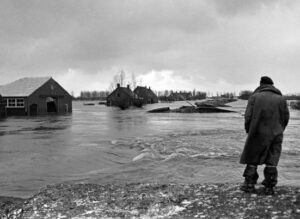
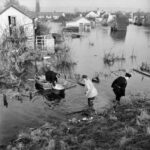 Warning sirens were put in place at the most at risk areas and are still in use today. The Dutch government quickly formed the Delta commission to study the floods and eventually commissioned the ‘Delta Works’ to enable the closing of estuaries to prevent upstream flooding and included dams, sluices, locks, dikes, levees, and barriers. Taxes were implemented and readily accepted with a national mind-set that this must never happen again. Even today, commemorations still happen on every anniversary for the dead.
Warning sirens were put in place at the most at risk areas and are still in use today. The Dutch government quickly formed the Delta commission to study the floods and eventually commissioned the ‘Delta Works’ to enable the closing of estuaries to prevent upstream flooding and included dams, sluices, locks, dikes, levees, and barriers. Taxes were implemented and readily accepted with a national mind-set that this must never happen again. Even today, commemorations still happen on every anniversary for the dead.
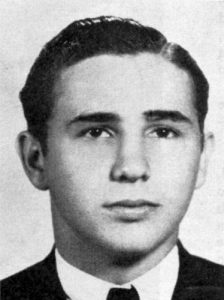
 Once upon a time, journalists and the media as a whole had an obligation to tell the truth, or at least tell the public that the story was their opinion only. The had to have reliable sources, even if they didn’t have to disclose them. While they weren’t “forced” to be truthful, they were completely shunned if they didn’t.
Once upon a time, journalists and the media as a whole had an obligation to tell the truth, or at least tell the public that the story was their opinion only. The had to have reliable sources, even if they didn’t have to disclose them. While they weren’t “forced” to be truthful, they were completely shunned if they didn’t.
When a journalist is mesmerized by someone, they can definitely fall hard for them. Such was the case with “the job-creating Führer with eyes that were like ‘blue larkspur.'” Why did so many journalists spend years dismissing the evidence of Hitler’s atrocities? Some, like the Christian Science Monitor called Hiter’s effect on Germany as providing “a dark land a clear light of hope.” They talked about how smoothly things were running, how well regulated everything was, and how great the police uniforms were. Strangely, when it came to the killing of the Jewish people, they said things like, “I have so far found quietness, order, and civility;” there was “not the slightest sign of anything unusual afoot.” As for all those “harrowing stories” of Jews being mistreated…they seemed to apply “only to a small proportion;” most were “not in any way molested.” They made it seem like as long as the number were “low,” the problem couldn’t possibly be a big one. Well, the reality as we all know now is that the “problem” was enormous, heinous, and horrific beyond imagination.
Trusting the journalists implicitly, without doing your own research is a very dangerous plan. Journalists have been known to assist in “hiding the evidence” in a matter…as we have seen in recent years. I don’t believe that all journalists are “bad” people, but those that are “bad” people ruin the reputation of journalism for every good journalist. I’m not even sure I would call some of the media, journalists. They are truly just “bad fiction writers,” in my opinion. Anyone who covers up the truth in the name of free speech or forces others to hide the truth in the name of tolerance is a bad journalist.
Many in the American mainstream newspaper industry portrayed the Hitler regime positively, especially in its 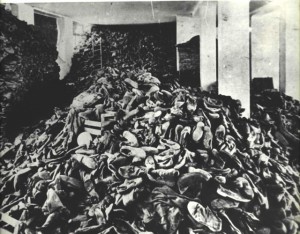
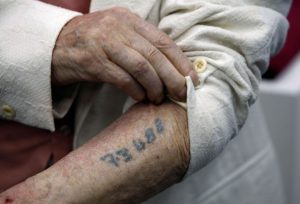 early months. Looking back now, we wonder how they could have said the good things they said about such a horrible dictator. The media published warm human-interest stories about Hitler, while simply excusing or rationalizing Nazi anti-Semitism. These actions should haunt the conscience of United States Journalism to this day. There was no excuse for what Hitler did, and to write it off as “not so bad” was absolutely inexcusable.
early months. Looking back now, we wonder how they could have said the good things they said about such a horrible dictator. The media published warm human-interest stories about Hitler, while simply excusing or rationalizing Nazi anti-Semitism. These actions should haunt the conscience of United States Journalism to this day. There was no excuse for what Hitler did, and to write it off as “not so bad” was absolutely inexcusable.
Of course, not all of the “bad journalism” of the day was sinister. Hitler was an unfamiliar subject when he first appeared on the international scene. His ideals and his movement were unknown, and so could have been mistaken for something quite innocent…at first. The Nazis had risen from barely 18 percent of the national vote in mid-1930 to become Germany’s largest party only two years later and gained power just months after that. I suppose that the political rise of Hitler could have just seemed like someone with great ideas stepping up to the microphone. It is thought that many American editors and reporters erroneously assumed, based on previous experience, that a radical candidate would show some restraint once in office, but that was not Hitler’s plan. He planned to take over the world…to become a One World Government. Really, any time anyone tries to take away the sovereignty of a country, they are not acting in the best interest of that country. That is something we must never forget.
An editorial in the Philadelphia Evening Bulletin on January 30, 1933, asserted that “there have been indications of moderation” on Hitler’s part. The editors of The Cleveland Press, on January 31, 1933, claimed the 
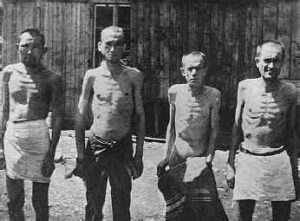 “appointment of Hitler as German chancellor may not be such a threat to world peace as it appears at first blush.” Frederick Birchall, Berlin bureau chief for The New York Times, found “a new moderation” in the political atmosphere following Hitler’s rise to power. Unfortunately, all of them were dead wrong!! Hitler was not a moderate. He was, in fact, more of a threat than they could ever have imagined. Hitler was the epitome of evil, and like it or not, any journalist who softened the story, was guilty of hiding the evidence.
“appointment of Hitler as German chancellor may not be such a threat to world peace as it appears at first blush.” Frederick Birchall, Berlin bureau chief for The New York Times, found “a new moderation” in the political atmosphere following Hitler’s rise to power. Unfortunately, all of them were dead wrong!! Hitler was not a moderate. He was, in fact, more of a threat than they could ever have imagined. Hitler was the epitome of evil, and like it or not, any journalist who softened the story, was guilty of hiding the evidence.
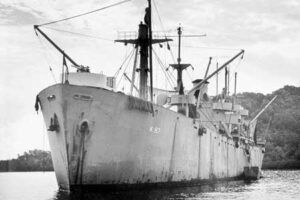 The ship that would eventually become the USS Serpens was built by California Shipbuilding Corporation in Wilmington, California. The ship was laid down March 10, 1943, as EC2 class Liberty Ship that was initially named SS Benjamin N. Cardozo (MCE hull 739). In the course of a little more than a month, SS Cardozo was transferred to the US Navy (USN) on April 19, 1943, and renamed USS Serpens (AK-97) after the star constellation Serpens. USS Serpens was commissioned May 28, 1943, at San Diego, and assigned to Captain Magnus J. Johnson, USCGR and manned by a crew from the US Coast Guard (USCG). From there, the ship led a relatively normal “life” for a ship. At least until the evening of January 29, 1945, when the USS Serpens (AK 97) was anchored off Lunga Beach, Guadalcanal, Solomon Islands. The Commanding Officer, Lieutenant Commander Perry L Stinson, and some of the enlisted men were ashore performing administrative functions.
The ship that would eventually become the USS Serpens was built by California Shipbuilding Corporation in Wilmington, California. The ship was laid down March 10, 1943, as EC2 class Liberty Ship that was initially named SS Benjamin N. Cardozo (MCE hull 739). In the course of a little more than a month, SS Cardozo was transferred to the US Navy (USN) on April 19, 1943, and renamed USS Serpens (AK-97) after the star constellation Serpens. USS Serpens was commissioned May 28, 1943, at San Diego, and assigned to Captain Magnus J. Johnson, USCGR and manned by a crew from the US Coast Guard (USCG). From there, the ship led a relatively normal “life” for a ship. At least until the evening of January 29, 1945, when the USS Serpens (AK 97) was anchored off Lunga Beach, Guadalcanal, Solomon Islands. The Commanding Officer, Lieutenant Commander Perry L Stinson, and some of the enlisted men were ashore performing administrative functions.
The remaining 970 crew members were loading depth charges when the USS Serpens suddenly exploded, leaving only the bow of the ship visible. The explosion was devastating, and only two sailors aboard…SN 1/C Kelsie K Kemp and SN 1/C George S Kennedy survived by clinging to the bow section of the ship, after escaping 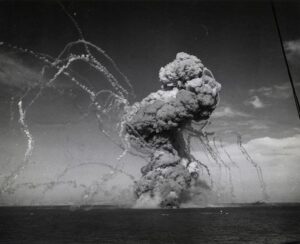 from the “bosun’s hole” inside the ship. The rest of the crew consisting of 198 Coast Guardsmen, 56 US Army stevedores, and Dr Levin, a US Public Health Service surgeon, died…most instantly. Of the 198 US Coast Guardsmen, 167 were reservists. In the immense explosion, nearby ships were damaged, and a US Army soldier on the beach was killed. The loss of the USS Serpens remains the largest single disaster ever suffered by the Coast Guard.
from the “bosun’s hole” inside the ship. The rest of the crew consisting of 198 Coast Guardsmen, 56 US Army stevedores, and Dr Levin, a US Public Health Service surgeon, died…most instantly. Of the 198 US Coast Guardsmen, 167 were reservists. In the immense explosion, nearby ships were damaged, and a US Army soldier on the beach was killed. The loss of the USS Serpens remains the largest single disaster ever suffered by the Coast Guard.
An eyewitness account of the disaster stated that, “As we headed our personnel boat shoreward the sound and concussion of the explosion suddenly reached us, and, as we turned, we witnessed the awe-inspiring death drams unfold before us. As the report of screeching shells filled the air and the flash of tracers continued, the water splashed throughout the harbor as the shells hit. We headed our boat in the direction of the smoke and as we came into closer view of what had once been a ship, the water was filled only with floating debris, dead fish, torn life jackets, lumber and other unidentifiable objects. The smell of death, and fire, and gasoline, and oil was evident and nauseating. This was sudden death, and horror, unwanted and unasked for, but complete.”
The Coast Guard initially though the explosion was an enemy attack. They actually continued to think that until 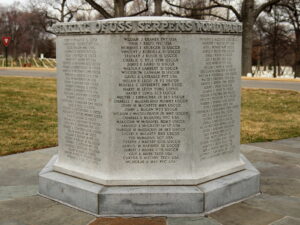 July 1947. By June 10, 1949, it was officially determined not to have been the result of enemy attack. Unfortunately, there would be no real answers as to what happened. The remains of the 250 men who lost their lives were originally buried at the Army, Navy, and Marine Cemetery in Guadalcanal with full military honors and religious services. Later, however, the remains were repatriated under the program for the return of World War II dead in 1949. The mass recommittal of the 250 unidentified dead took place in section 34 at MacArthur Circle, Arlington National Cemetery. The remains were placed in 52 caskets and buried in 28 graves near the intersection of Jesup and Grant Drives. The two survivors both earned the Purple Heart injuries sustained.
July 1947. By June 10, 1949, it was officially determined not to have been the result of enemy attack. Unfortunately, there would be no real answers as to what happened. The remains of the 250 men who lost their lives were originally buried at the Army, Navy, and Marine Cemetery in Guadalcanal with full military honors and religious services. Later, however, the remains were repatriated under the program for the return of World War II dead in 1949. The mass recommittal of the 250 unidentified dead took place in section 34 at MacArthur Circle, Arlington National Cemetery. The remains were placed in 52 caskets and buried in 28 graves near the intersection of Jesup and Grant Drives. The two survivors both earned the Purple Heart injuries sustained.

 Tragedy never really goes away. Of course, it forever stays with the families of the lost, but some tragedies leave us with deeper feelings than other tragedies. Some tragedies touch our very core. Of course, those tragedies are the kind that are known, and felt, around the world. Like every national tragedy, we remember where we were when we first heard about the Challenger Disaster. Nasa had been losing its draw to a degree, but this mission was to be the first time a civilian would go up in space, and NASA had chosen a teacher for that all important mission. Her name was Christa McAuliffe. Of course, she was only one member of that tragic mission, and truly no more or less important than any of the others. These people had worked hard to become a team. The names of the rest of the crew were Dick Scobee (Commander), Michael J Smith (Pilot), Ronald McNair (Mission Specialist), Ellison Onizuka (Mission Specialist), Judith Resnik (Mission Specialist), and Gregory Jarvis (Payload Specialist).
Tragedy never really goes away. Of course, it forever stays with the families of the lost, but some tragedies leave us with deeper feelings than other tragedies. Some tragedies touch our very core. Of course, those tragedies are the kind that are known, and felt, around the world. Like every national tragedy, we remember where we were when we first heard about the Challenger Disaster. Nasa had been losing its draw to a degree, but this mission was to be the first time a civilian would go up in space, and NASA had chosen a teacher for that all important mission. Her name was Christa McAuliffe. Of course, she was only one member of that tragic mission, and truly no more or less important than any of the others. These people had worked hard to become a team. The names of the rest of the crew were Dick Scobee (Commander), Michael J Smith (Pilot), Ronald McNair (Mission Specialist), Ellison Onizuka (Mission Specialist), Judith Resnik (Mission Specialist), and Gregory Jarvis (Payload Specialist).
We all think we know what happened that fateful day…an explosion, right? Not exactly. Just 73 seconds after liftoff, the space shuttle was engulfed in what is now being called a cloud of fire, at an altitude of 46,000 feet. It looked like an explosion, the media called it an explosion, and even NASA officials mistakenly described it that way initially. Nevertheless, the reality is that in fact, there was no detonation or explosion…at least not in the way we understand an explosion to be. Actually, a seal, manufactured years before the launch, in the shuttle’s right solid-fuel rocket booster designed to prevent leaks from the fuel tank during liftoff weakened in the frigid temperatures in Florida that day. When the seal failed, hot gas began pouring through the leak. Instead of exploding, the fuel tank actually collapsed and tore apart, and the resulting flood of liquid oxygen and hydrogen created the huge fireball believed by many to be an explosion, but it was actually just a fire.
The Challenger didn’t disintegrate right away. In fact, it remained momentarily intact and actually continued moving upwards with its forward momentum. Then, as it shot forward, powerful aerodynamic forces actually pulled the orbiter apart. The pieces…including the crew cabin…reached an altitude of about 65,000 feet before losing its momentum and falling out of the sky into the Atlantic Ocean below. At that point, the crew, who had most likely survived the initial breakup of the shuttle, was unconscious due to loss of cabin pressure and probably died due to oxygen deficiency pretty quickly. The cabin hit the water’s surface traveling at speeds of more than 200 miles per hour. It hit the water a full 2 minutes and 45 seconds after the shuttle broke apart. No one knows if the crew might have regained consciousness in the final few seconds of the fall, and I certainly hope that is not the case. I would much rather that they had no idea what was coming, and if they were awake, they certainly would have known. We will never know, of course.
Salvage operations began immediately, and I’m sure that they hoped against hope to be able to find some of the crew still alive. Within a day of the shuttle tragedy, salvage operations had recovered hundreds of pounds of metal from the Challenger. As hopes turned to sad resolve, the salvage operation continued. They kept looking and finally in March 1986, the remains of the astronauts were found in the debris of the crew cabin. By the time NASA closed its Challenger investigation in 1986, all of the important pieces of the shuttle were retrieved. Nevertheless, most of the spacecraft remained in the Atlantic Ocean, where I’m sure, they thought it would remain. Then, a decade later, eerie memories of the disaster resurfaced when two large pieces of the Challenger washed up in the surf at Cocoa Beach, about 20 miles south of the Kennedy Space Center at Cape Canaveral. NASA believed the two barnacle-encrusted fragments came from the shuttle’s left wing flap. It is 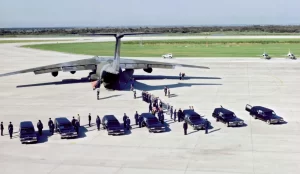
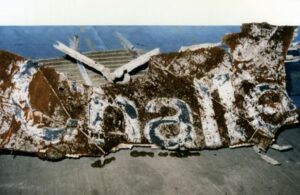 thought that the two pieces were once connected. One piece measured more than 6 feet wide and 13 feet long. Once they were officially verified, the pieces of Challenger were placed in two abandoned missile silos with the other shuttle remains, which number around 5,000 pieces and weigh in at some 250,000 pounds.
thought that the two pieces were once connected. One piece measured more than 6 feet wide and 13 feet long. Once they were officially verified, the pieces of Challenger were placed in two abandoned missile silos with the other shuttle remains, which number around 5,000 pieces and weigh in at some 250,000 pounds.

 This past year has been one filled with excitement, change, and growth for my niece, Lacey Stevens. Lacey, who is a hairdresser, opened her own salon. It’s called LuxLou Beauty Salon, and her business is really growing. Most of her family and friends go to Lacey regularly…not to mention the new people who have been referred to her. Lacey not only does people’s hair for their everyday life, but she also specializes in hair and makeup for their weddings, which as we all know is the most important day in a girl’s life. You want the best for that special day, and Lacey is an expert in providing the very best look for that all-important day. Lacey is very good at what she does, and she listens to her clients, to make sure she does exactly as the want it to be. Going forward, I know that Lacey’s business will only grow bigger and bigger.
This past year has been one filled with excitement, change, and growth for my niece, Lacey Stevens. Lacey, who is a hairdresser, opened her own salon. It’s called LuxLou Beauty Salon, and her business is really growing. Most of her family and friends go to Lacey regularly…not to mention the new people who have been referred to her. Lacey not only does people’s hair for their everyday life, but she also specializes in hair and makeup for their weddings, which as we all know is the most important day in a girl’s life. You want the best for that special day, and Lacey is an expert in providing the very best look for that all-important day. Lacey is very good at what she does, and she listens to her clients, to make sure she does exactly as the want it to be. Going forward, I know that Lacey’s business will only grow bigger and bigger.
While her business is really big news, the most exciting news is that Lacey got engaged to her boyfriend, Chris Killinger just before Christmas. These two are perfect for each other, and Lacey is already a wonderful stepmom to Chris’ two kids, Brooklyn and Jaxon. They love her and our whole family, and we all love them. While many 
 people might think that having a “ready-made family” would be tough, Lacey has embraced it and truly considers Chris’ kids her own. That is as it should be. When you marry a person with children, you marry the whole family. The best stepparents know and embrace that, and it helps that Brooklyn and Jaxon are very sweet. Lacey also has a soft heart, and she is very loving to children, so it’s a blessing to all.
people might think that having a “ready-made family” would be tough, Lacey has embraced it and truly considers Chris’ kids her own. That is as it should be. When you marry a person with children, you marry the whole family. The best stepparents know and embrace that, and it helps that Brooklyn and Jaxon are very sweet. Lacey also has a soft heart, and she is very loving to children, so it’s a blessing to all.
Lacey has been helping Chris with updates to their house. They have been painting, and they also updated the bathroom, which turned out great. This is somewhat new to Lacey, but she is always willing to learn new things and help him with improvements to their home. It’s always fun to watch the changes that people go through as they blend their lives. What one person knows and has done, the other might not have, but when you blend them together, each can teach the other something new…be it a skill or a style.
Now that they are engaged, Lacey and Chris are very busily planning their wedding, scheduled for October. I know it is going to be as beautiful as these two are, and we are all very excited for them. I guess Lacey won’t need to hire someone to do her makeup, because she is the best person for the job. Her own hair and makeup always look perfectly stunning, so unless she just wants to be pampered, why go elsewhere. Of course, we don’t know any of the other details of the wedding plans, and that is as it should be, but I know it will be 

 perfect, and I am very happy for these two. Today is Lacey’s 30th birthday. It’s the perfect time for Lacey to begin the next chapter of her life, but I can’t believe she isn’t a little girl of 3. Where has the time gone. Happy birthday Lacey!! Have a great day!! We love you!!
perfect, and I am very happy for these two. Today is Lacey’s 30th birthday. It’s the perfect time for Lacey to begin the next chapter of her life, but I can’t believe she isn’t a little girl of 3. Where has the time gone. Happy birthday Lacey!! Have a great day!! We love you!!

